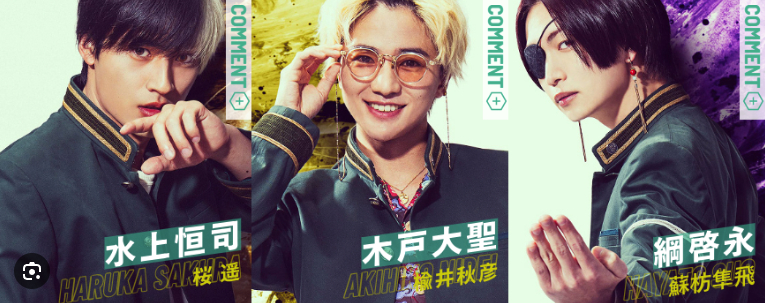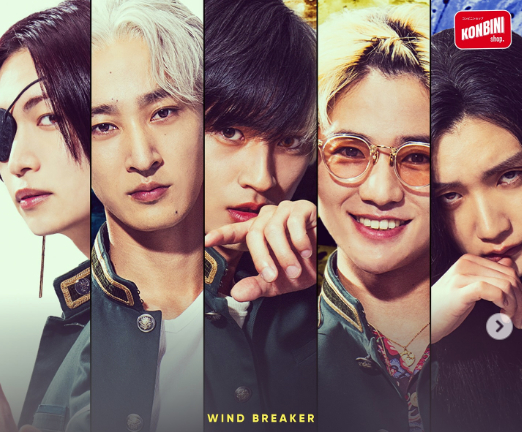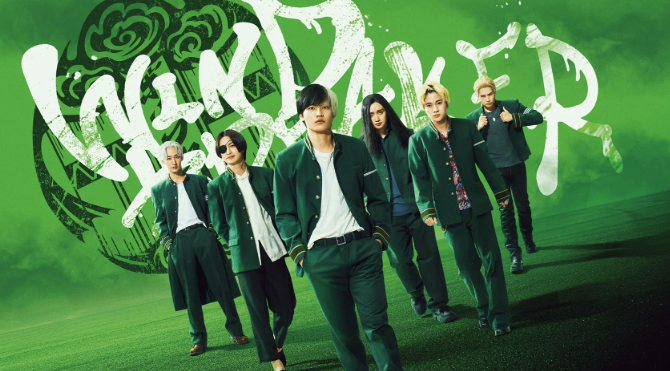WIND BREAKER (2025)
WIND BREAKER (2025) brings the raw, unfiltered energy of Satoru Nii’s manga to life in a live-action adaptation that’s equal parts grit, heart, and explosive style. Directed by Kentaro Hagiwara, known for his flair in adapting stylized worlds (Tokyo Ghoul, Blue Period), this film transforms the gritty urban jungle of Makochi into a battlefield where fists speak louder than words—and where strength is measured not just by power, but by purpose.
Plot Overview
Set in the delinquent haven of Makochi, the story follows Haruka Sakura (Kōshi Mizukami), a lone wolf transfer student with heterochromatic eyes and a chip on his shoulder. Driven by the desire to become the strongest, Haruka enrolls at Furin High School, a school once feared for its rowdy reputation but now known as a force of justice—a vigilante-like organization where students patrol their city to protect it from chaos.

As Haruka attempts to assert his dominance in a school full of capable brawlers, he is pulled into the simmering conflict with Shishitoren, a rival gang led by the enigmatic Choji Tomiyama (Kōki Yamashita) and his fierce right-hand, Jo Togame (Noritaka Hamao). What follows is a volatile mix of brotherhood, street fights, and emotional revelations as Haruka not only finds worthy opponents, but also uncovers what it means to fight with others, not just against them.
The narrative balances stylized action with grounded emotional arcs, culminating in a fierce showdown during the Shishitoren Arc—a major turning point for the characters and the city they call home.
Themes and Emotional Depth
At its core, WIND BREAKER is not just about fists and fury—it’s about loyalty, self-discovery, and fighting for something greater than yourself. It explores the lives of misunderstood youth cast aside by society, who find meaning through community, brotherhood, and an evolving sense of justice.

The film dives deep into themes of redemption and identity, showing how people once considered “delinquents” can become protectors and role models. Haruka’s journey is one of emotional thawing: from cold ambition to reluctant acceptance of friendship and purpose. Each major character brings a unique struggle—whether it’s loneliness, pride, or trauma—that is channeled into stylized combat sequences.
These fights aren’t just flashy—they’re personal. Every punch tells a story, every clash is laced with pride, and every confrontation adds weight to the film’s central question: what does it mean to be strong?
Character Development and Performances
Kōshi Mizukami as Haruka Sakura is a force of nature. With a stoic presence and internal tension bubbling just beneath the surface, he perfectly captures Haruka’s duality: aloof and ruthless on the outside, vulnerable and searching on the inside. His transformation across the film feels authentic and earned, and his physicality in the action scenes is standout.
Kōki Yamashita brings a quiet intensity to Choji Tomiyama, embodying a charismatic yet unhinged leader who contrasts Haruka’s calculated rage with theatrical dominance. Noritaka Hamao as Jo Togame provides a sharp edge and cold intelligence, becoming a memorable antagonist in his own right.
Supporting cast members Taisei Kido, Keito Tsuna, JUNON, Motoki Nakazawa, and Shūhei Uesugi add depth and camaraderie to the ensemble. Their banter, rivalries, and moments of solidarity breathe life into the world of Furin High. Rikako Yagi as Kotoha Tachibana, the school’s emotional anchor, shines in her moments of quiet strength and fierce loyalty.

Cinematography and Direction
Kentaro Hagiwara’s direction balances stylized flair with grounded emotion. The fight scenes are kinetic and tightly choreographed, incorporating martial arts, street-fighting grit, and manga-inspired cinematography. Long takes, slow motion, and dramatic lighting elevate each battle into a visual statement, not just a physical one.
Shot on location in Okinawa, the film’s urban set design captures the essence of Makochi’s gritty neighborhoods, using neon hues and graffiti-covered walls to reflect the chaos and camaraderie of gang life. The color-coded gang uniforms and stylized character intros remain faithful to the manga’s visual identity, enhancing the film’s immersion.
The sound design is equally striking—bass-heavy music pulses through the fights, while emotional scenes rely on minimalistic piano and ambient tones to underscore vulnerability. The contrast heightens both tension and catharsis.
Final Verdict
WIND BREAKER (2025) is a rare example of a live-action manga adaptation that understands both the aesthetic and emotional core of its source material. With bold visuals, standout performances, and a beating heart beneath its bruised knuckles, it transcends the brawler genre and becomes a story of growth, loyalty, and chosen family.
It’s a celebration of rebellion not as destruction, but as a stand against apathy. A story where strength is redefined—not by dominance, but by the willingness to fight for others, not just against them.
Rating: 9/10
A stylish and emotionally resonant action drama, WIND BREAKER delivers knockout punches with both its fists and its heart. Whether you’re a fan of the manga or new to the story, this adaptation will leave you breathless and inspired.
